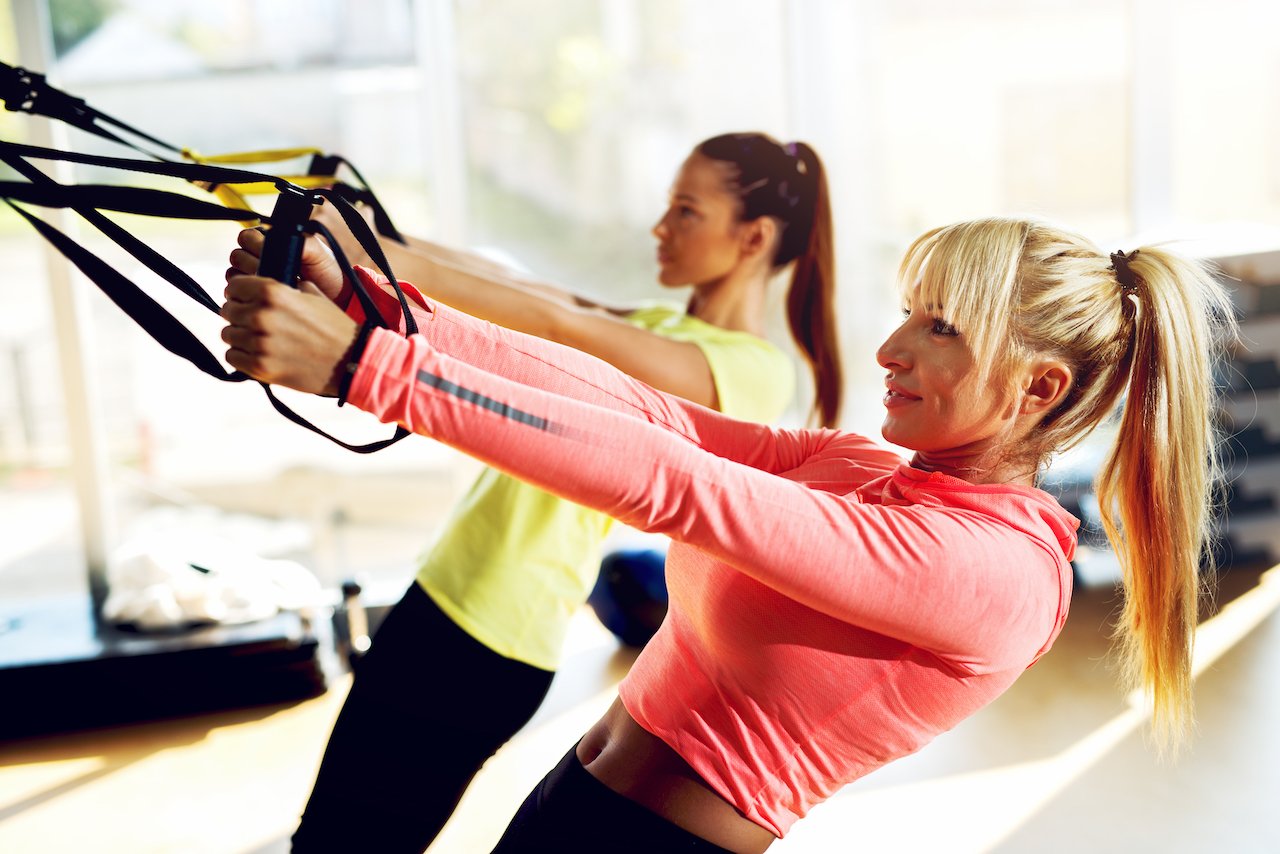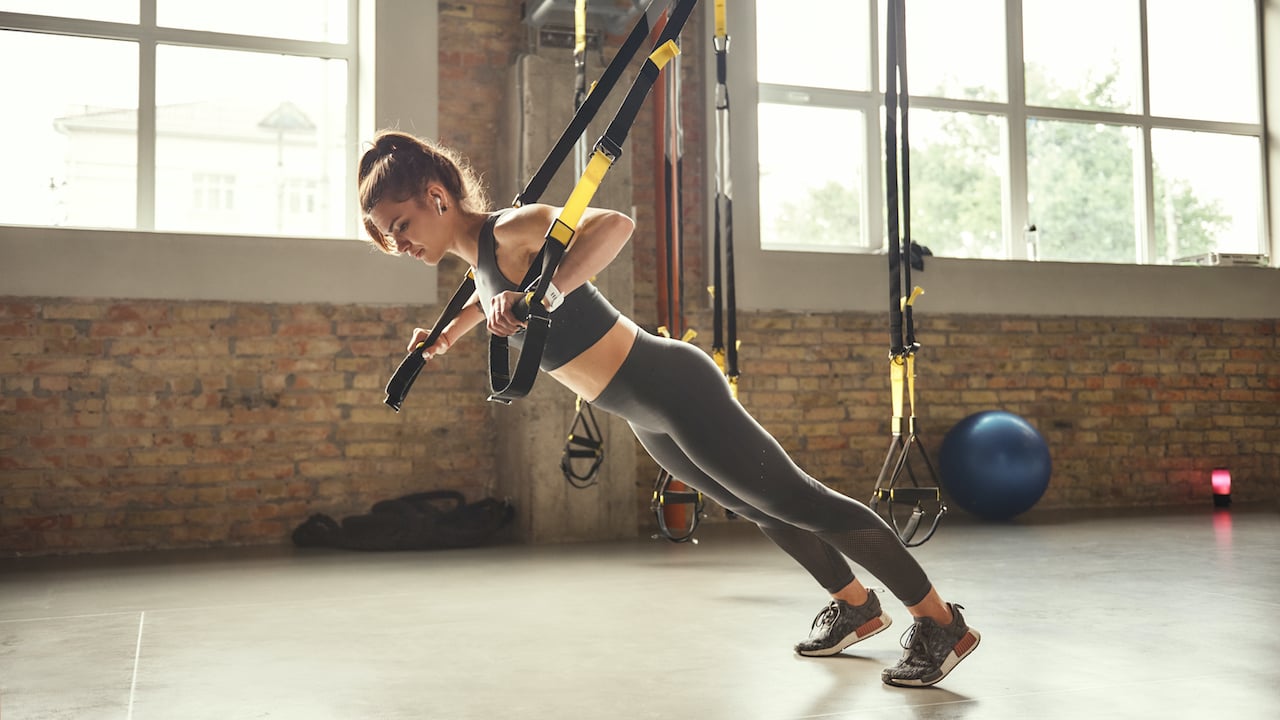It was my gym, but I was terrified. The first time I saw a TRX in my gym, I was curious and, frankly, compelled to give it a shot. But as soon as I gripped the strap handles I realized I had no idea what I was doing. I’d heard of TRX but had never seen suspension training before. Now, I was pretty sure the entire gym was going to see me suspended in the air, then fall flat on my face. 😵
And that’s basically exactly what happened. Sure, my first suspension training workout was a total disaster. But it only made me more committed. The more I learned about TRX, the more I realized I absolutely had to incorporate it into my workout routine. As you’ll see, the benefits are incredible.
If you’re new to suspension training, hang tight! We’ll go over the what’s, why’s, and how’s, so you don’t have to find yourself doing an embarrassing faceplate in front of the whole gym.
Here’s what we’ll cover
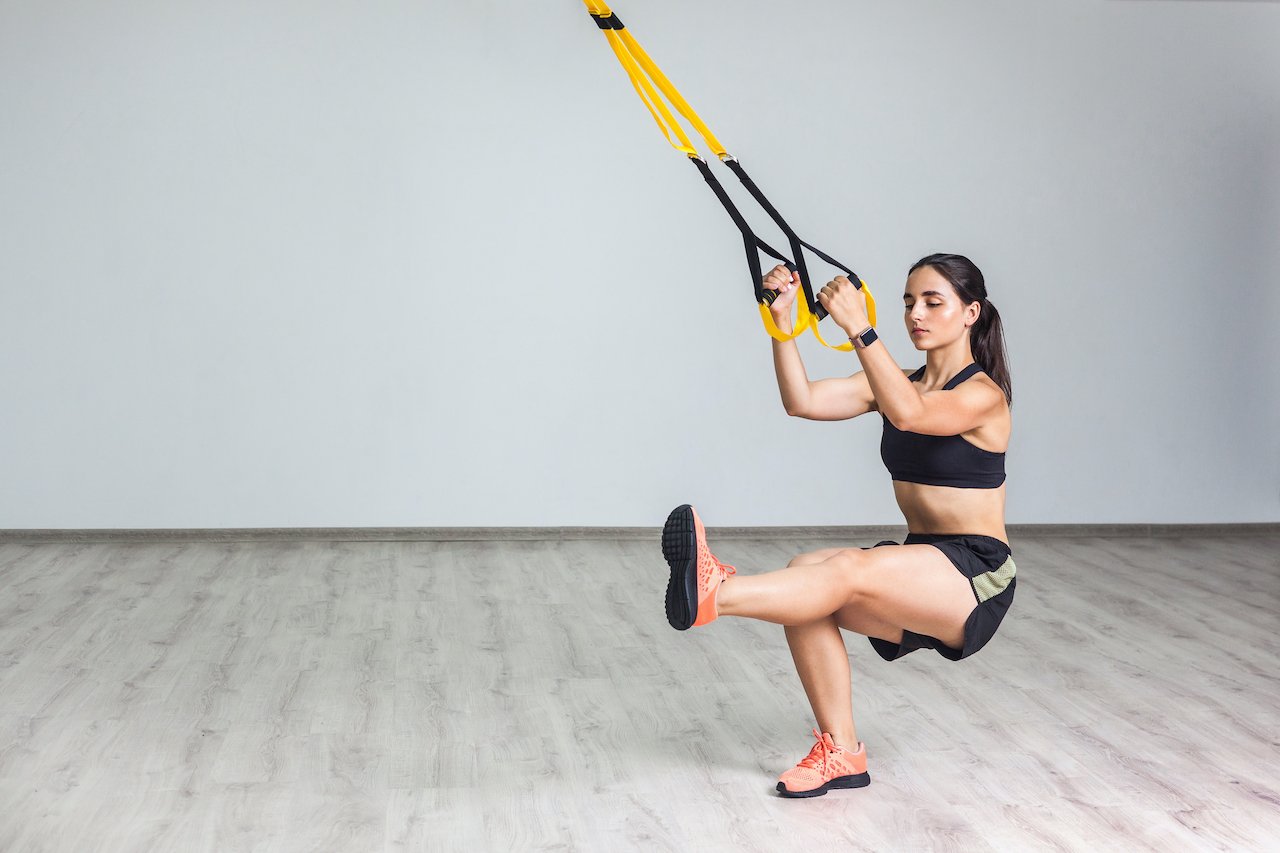 What Is Suspension Training?
What Is Suspension Training?
Suspension training entered its current heyday after TRX was introduced to the world. TRX (which stands for Total Resistance Training) is a brand invented by Randy Hetrick, professional fitness coach and former U.S. Navy SEAL. Today, the brand name TRX has become synonymous with suspension training, and is a common sight in gyms, yoga studios, physical therapy facilities, homes, and anywhere fitness fanatics tend to congregate.
Though there are different forms of suspension training (which we’ll get into in a bit), the predominating approach uses adjustable straps, not unlike cam straps you’d use to buckle down the contents in the bed of a pickup. That is to say, they’re sturdy. But also unstable, which makes them particularly effective at targeting core and stabilizing musculature. [1]
Suspension training is a great way to practice impact-free, core-blasting exercises that can lead to long-term physical benefits. [2] This makes suspension training an excellent workout for people with joint pain, inhibited mobility, and healing injuries. A couple years ago, I spent five months in physical therapy, and used a TRX three days a week as part of my rehab. That said, you should always consult a doctor or physical therapist if you have any of these issues.
How Does Suspension Training Work?
When performing a TRX-style suspension training workout, parts of your body (almost always limbs) are attached or gripping to hanging straps. The first thing TRX workout newbies notice is… a whole lot of shaking. That’s what I mean by instability. Don’t worry—you’ll improve!
The unstable environment pins your bodyweight against the forces of gravity, exercising multiple joints in multiple different directions. This is called multi-joint, multi-planar exercising. Instability occurs by leaning into or away from the straps, effectively suspending your bodyweight. With no solid surface, you essentially find yourself in a state of both balance and exertion. What separates your TRX workout from stable and free-weight exercises is that you can set the straps to different heights, or adjust your body closer or further from the straps to increase or decrease your body angle—equivalent to adding/reducing weight in a non-suspension training workout.
Electromyography (EMG) in TRX workout studies has shown that stability training seriously activates large muscle groups in the core and torso. The dynamic nature of a TRX workout allows you to perform a variety of exercises targeting small and large muscle groups alike. Because of the substantial core muscular activation, suspension training is considered a promising activity for optimal muscle strength, mass, power, and functional performance. [3,4]
What does that mean in normal-people speak? Well, you’ll be able to tone down, while strengthening up and preserving your muscles for a lifetime of activity. Remember, it’s just you, gravity, and a pair of heavy-duty straps. So your suspension training workout is only limited by your creativity.
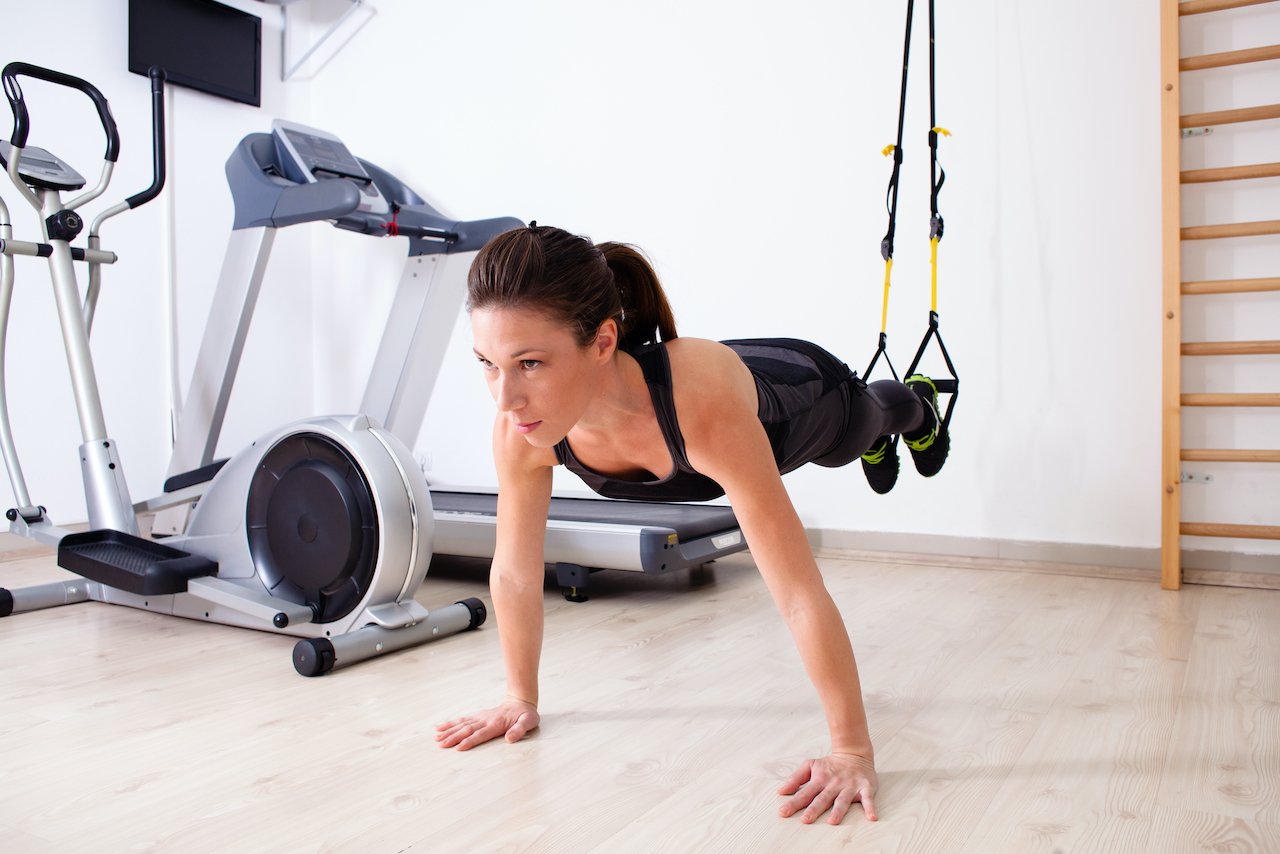
The 6 “deadly sins” of the TRX
To avoid adding a wipe out to your workout (or, worse, getting injured) follow all the do’s mentioned above—but don’t forget about the don’ts. Be sure to avoid these “six deadly sins of suspension training”:
- Starting incorrectly. Find the correct endpoint for your TRX straps. Don’t just jump right in; make sure you position your body with the proper foot stance for the exercise you’re doing.
- Sawing. Pretty sure it says right there on the box, but TRX is not a toy. No seesawing. Keep even pressure on both straps to avoid slipping. Got that? Good.
- Stopping. Best way to tank on your tush, guaranteed. If you find yourself unable to complete a movement, don’t stop; instead, adjust your body to reduce resistance. Remember, versatility is what makes suspension training so effective!
- Scraping. Against your arms, legs, hands… honestly, just avoid letting the straps rub against your arms abrasively. You don’t want to have to explain rope burns at work. Trust me on that. 😬
- Slacking. Not just in effort, but with your straps. You should be maintaining strap tension throughout the entirety of each repetition.
- Sagging. Bad posture is the easiest path to injury. When tired, it may be harder to maintain good exercise posture. Focus on keeping your core engaged and your body aligned to avoid letting your hips sag and put undue pressure on your spine and shoulders.
Benefits Of Suspension Training
There are many reasons to adopt a suspension training workout. But if you need convincing, here are some of indisputable benefits:
Excellent for core strength
Core strength is easily the #1 benefit of suspension training. And that’s a good thing, because your core is arguably the #1 muscle group your body relies on. Harvard Medical School puts it bluntly: “Whether you’re hitting a tennis ball or mopping the floor, the necessary motions either originate in your core, or move through it.” [5] Your core muscles consist of the abs, glutes, paraspinal, diaphragm, hip girdle, and pelvic floor. And they’re responsible for almost all physical activity we do. Because of this, a strong core can decrease back pain and improve posture. [6] The bad news is that many people have weak cores. The good news is that suspension training has been proven to activate your core muscles far better than stable exercises (such as floor workouts or weight lifting). [7]
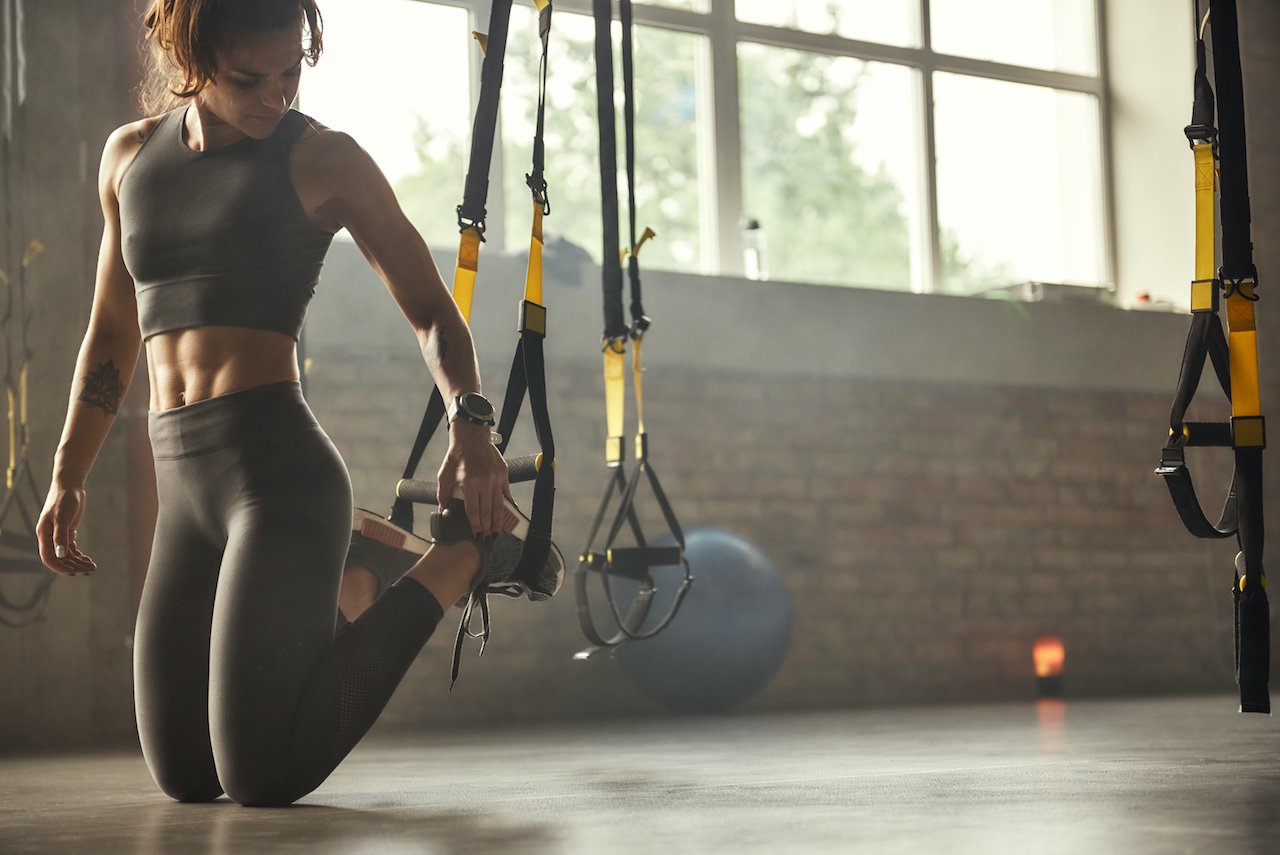
Great for hitting your health & fitness goals
When TRX first emerged onto the workout scene a decade ago or so, there was scant evidence of the benefits it provided. Today, the evidence is indisputable. Properly applied, suspension training will help you see gains across your fitness goals. What’s more, it will also help you see losses—the good kind!
In a recent study by the American Council of Exercise, TRX suspension training led to “significant decreases in the following areas:”
- Waist circumference
- Body-fat percentage
- Resting blood pressure
This means that, with the right exercises, your suspension training workout routine can increase not just your strength, but your physique and cardiovascular health. [8] And if you’re looking to amplify your results, consider pre- and post-workout supplements. SkinnyFit offers two fantastic, all-natural workout powders.
Jump Start gives you an incredible energy boost and focus to keep you motivated through your workout. The best part is, you won’t experience the stamina crash that accompanies so many pre-workout powders. For after a workout, I never—ever—go without Repair & Recover. This is a BCAA (branched-chain amino acid) supplement that helps muscles recover from intense workouts. It’s incredibly important for muscle health. Think of BCAAs as the fitness equivalent of flossing: it’s arguably the best thing you can do, but most people ignore it… then lie about it to their dentists! 😅But seriously, don’t go without BCAAs after a workout. And if all-natural matters to you (and it should), Repair & Recover is an obvious go-to.
Suitable for all fitness levels
One of the things I love most about diving into a suspension training workout is the exceptional degree of personalization you can get from the suspension straps. In just seconds, you can adjust the straps to increase or decrease resistance. Beyond adjusting the height of the straps, simple changes in your body positioning and modifications in your technique can increase/decrease resistance or target different muscles. This makes suspension training suitable for people at every point on their fitness journey.
If you’re new to working out and haven’t developed stable core muscles, you can soften your suspension angle and focus on beginner-level exercises, gradually increasing the intensity of your workout as you get stronger. And even if you’re a top-level fitness guru, you’ll immediately recognize the endless opportunities to target nearly every muscle in your body.
Improves stability
Joint stability is defined as “strength of the bond between the bones and a joint.” [9] Needless to say, it’s important for maintaining healthy joints. And a good suspension training workout routine goes a long way in increasing joint stabilization.
In fact, TRX suspension training is used by the Head Athletic Trainer of the Boston Red Sox to help increase the dynamic stability of fine stabilizer muscles, such as the scapula, in top athletes. [10] But it’s not just pro baseball players who rely on stability muscles—we all need stable joint muscles to protect joints like shoulders and knees from injury.
Takes up very little space
Another reason suspension training needs to be on your radar is that you can have one at home without making your place look like a makeshift gym. TRX suspension trainers are remarkably compact, so storage is never a problem. Most at-home suspension trainers hang from your door, so even if you don’t put them away, they still won’t take up a lot of room. (A little hint I learned the hard way: If you are doing your suspension training workout at home, make sure to let people know not to open the door you’re hanging your TRX from. Otherwise it’s an embarrassing crash waiting to happen.)
Types Of Suspension Trainers
I’ve spoken a lot about the TRX brand of trainers. While it is indeed the most famous, it’s by no means the only type of suspension training. There are many different styles and equipment waiting for you to explore.
- Gymnastics rings may actually be the most famous (and original?) type of suspension training, and still a phenomenal exercise.
- Yoke bars feature a single attachment that branches into a wide bar with attachments on each end. This means you’re working with three attachment points. Now that’s a challenge!
- Slack lines may not technically fall in the category of suspension training equipment, but they *are* suspended and work your core like crazy. Slack lining increases your balance and lower body muscles like nothing else. It’s also super fun, challenging, and great for camping trips!
- Swings! Yep, playground swings are excellent for an impromptu suspension training workout. The narrow two-point attachment allows you to work your stabilizers and core, and you can do so while your kids play.
Full Body TRX Workout
Now that you’ve pretty know the ins and outs of suspension training, it’s time to dive into a workout that will absolutely whoop your butt… as well as shoulders, chest, and abs.
Complete 1 minute of each exercise with little to no rest between exercises. Complete 3-5 sets, resting for 1 minute between each set.
- TRX Rows – Suspend from your trainer’s handles, leaning backwards at a degree you’re comfortable with. Increase or decrease your angle to increase or decrease resistance. Don’t forget to keep your toes tucked up so that you’re on your heels.
- TRX Chest Press – With your arms suspended, support yourself at about a 40º-60º angle. Bend your elbows and lower until your chest reaches the handles, then push yourself up, push-up style.
- TRX Balance Lunge – Start by balancing with your right foot out. Lower into a lunge by bending your right leg behind you. Push yourself up with your left leg, extending your hips and returning your right leg to the starting position. Alternate.
- TRX Hamstring Curl – In a supine position with your palms on the floor and heels firmly in the strap of your TRX, engage your core and glutes. (Point those toes back toward you!) Pull your knees up toward your chest while exerting force into the straps through your heels.
- TRX Kneeling Rollout – With both knees on the ground, grip the handles tightly and lock your elbows. Lean your weight forward, arms reaching out overhead, and lower your body as far as you can, keeping your upper body straight. Push down on the handles to return to your starting position. If you feel pain in your lower back, try not extending so far. If pain persists, stop immediately.
There are endless possibilities for suspension training exercises. Work more into your routine as your progress!
